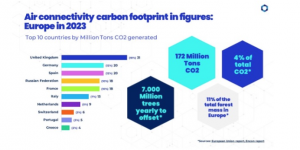Aviation’s European carbon footprint grew by 16% during 2023

Mabrian, a leading company in tourism intelligence, has shared the results of a new study on the impact of aviation on the carbon footprint and tourism sustainability of European destinations in 2023, during its participation in a virtual session organized by UN Tourism and the European Travel Commission (ETC) on measuring the carbon footprint of the tourism sector.
he study provides a detailed insight into various important aspects, including the main indicators of the carbon footprint generated by air travelers, the relationship between this footprint and the destination’s tourism revenue, and the dependence of destinations on origin markets and the distance to these markets. Additionally, it examines the impact of long-haul flights and provides specific data on aviation’s contribution to CO2 emissions in the tourism industry.
Thus, Mabrian reveals that, in Europe during the year 2023, the countries that significantly contributed to aviation-related CO2 emissions include, in this order, the United Kingdom, Germany, Spain, Russia, and France. These countries represent a significant portion of the total CO2 emissions generated by tourism, according to incoming flight data to these countries, regardless of their origin. At the bottom end of the top 10 European countries by CO2 volume generated are Italy, the Netherlands, Switzerland, Portugal, and Greece.
Specifically, in 2023, the United Kingdom led the ranking with 31.4 million tons of CO2 generated, representing 18% of the total emissions. Germany and Spain followed with 20 million tons each, both accounting for 12% of the share in total emissions in Europe. Russia and France ranked fourth and fifth, contributing 18 million tons each, equivalent to 10% each. Italy ranked sixth with 13 million tons (7%), followed by the Netherlands with 9 million tons (5%). Switzerland and Portugal shared the eighth and ninth positions, generating 6 and 5 million tons respectively, each representing 3%. Greece closed the list with 4 million tons, contributing 2% of the total CO2 emissions.
There is a significant variation in emissions generated compared to 2022, increasing by 16% overall. This is especially notable in some countries such as the United Kingdom with an increase of 24.20%, followed by Italy with an increase of 22.69%, and France with an increase of 15.93%.
According to the analyzed data, in 2023, the aviation sector generated approximately 172 million tons of CO2 in Europe, equivalent to 4% of the total CO2 generated on the continent, according to the European Union’s estimates. To offset this carbon footprint, an estimated 7 billion trees per year are needed, which represents 11% of the total forest mass in Europe, according to the European Union’s estimates and the Encon consultancy report.
ADVERTISEMENT
Carlos Cendra, partner and Director of Marketing and Communication at Mabrian, comments that “this analysis does not intend to point fingers at the aviation industry, which is essential for the tourism sector and is making significant strides in decarbonization, but rather aims to raise awareness among tourist destinations of the need to measure the impact their visitors have on the environment, in order to act accordingly, take compensatory measures, and advance towards the Net Zero or climate neutrality goal set for 2050. Undoubtedly, measurement is the key to being able to take action and achieve the set objectives. On the other hand, we propose using cross-indicators, such as the relationship between carbon footprint and visitor-generated income in the destination’s local economy, which allow for better measurement of the impact from a balanced perspective.”

